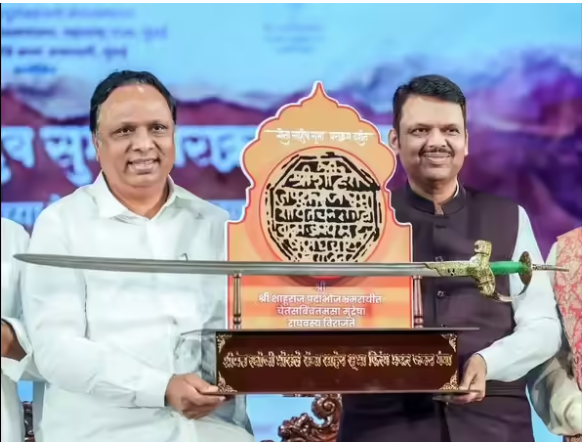Maharashtra
Sword of Raghuji Bhonsle
- 19 Aug 2025
- 3 min read
Why in News?
Chief Minister Devendra Fadnavis on Monday inaugurated the seven-day exhibition where the newly obtained sword of Maratha commander Shrimant Raje Raghuji Bhonsle will be exhibited.
Key Points
- Exhibition Details: The exhibition will run from 18th-25th 2025 at the PL Deshpande Maharashtra Kala Academy and will include the sword and displays of 12 heritage forts listed as UNESCO World Heritage sites.
- Acquisition: The Maharashtra government purchased the sword for Rs 45 crore at a London auction as part of a broader initiative to reclaim historical artefacts connected to the Maratha empire.
- The government has reclaimed important artifacts like the 'wagh nakh' (used by Shivaji Maharaj) and is working on building memorials for Chhatrapati Shivaji Maharaj outside Maharashtra, with an initial project underway in Agra, Uttar Pradesh.
- Significance of Sword: Raghuji Bhosale was a prominent Maratha commander and the founder of the Nagpur Bhosale dynasty.
- The 18th-century Maratha-style 'firangi' sword combines a European blade with an Indian hilt, showcasing intricate ornamentation, including gold inlay koftgiri work.
- The spine of the blade features an inscription in Devanagari script, connecting it to Raghuji Bhosale's title given by Chhatrapati Shahu Maharaj.
- The sword was used during military campaigns in the 18th century, including battles against the Nawab of Bengal (1745 and 1755) and in regions like Chhattisgarh, Odisha, and southern India.
Raghuji Bhosale I (1695 – 1755)
- Founder: He was the founder of the Nagpur Bhosale dynasty and a prominent commander in the Maratha army during Chhatrapati Shahu Maharaj’s reign.
- Title: Impressed by his bravery and military strategy, Chhatrapati Shahu Maharaj conferred upon him the title ‘Senasahib Subha’.
- Campaign: He established control over Chanda, Chhattisgarh, and Sambalpur and defeated the Nawabs of Cuddapah and Kurnool, thereby asserting Maratha military and political dominance in southern India.
- His kingdom was abundant in iron and copper, which were used for both manufacturing goods and crafting weapons.
- In 1817, the Nagpur Bhosales battled the British East India Company at Sitabuldi (3rd Anglo-Maratha War (1817-19)), and after the Company's victory, their treasury, including valuables, jewelry, and weapons, was looted.
- After Nagpur was annexed, the British also received tribute and gifts from the Bhosales over time.
- Experts believe that Raghuji Bhosale’s sword may have left India either as part of the war loot or as a gift to the British.







